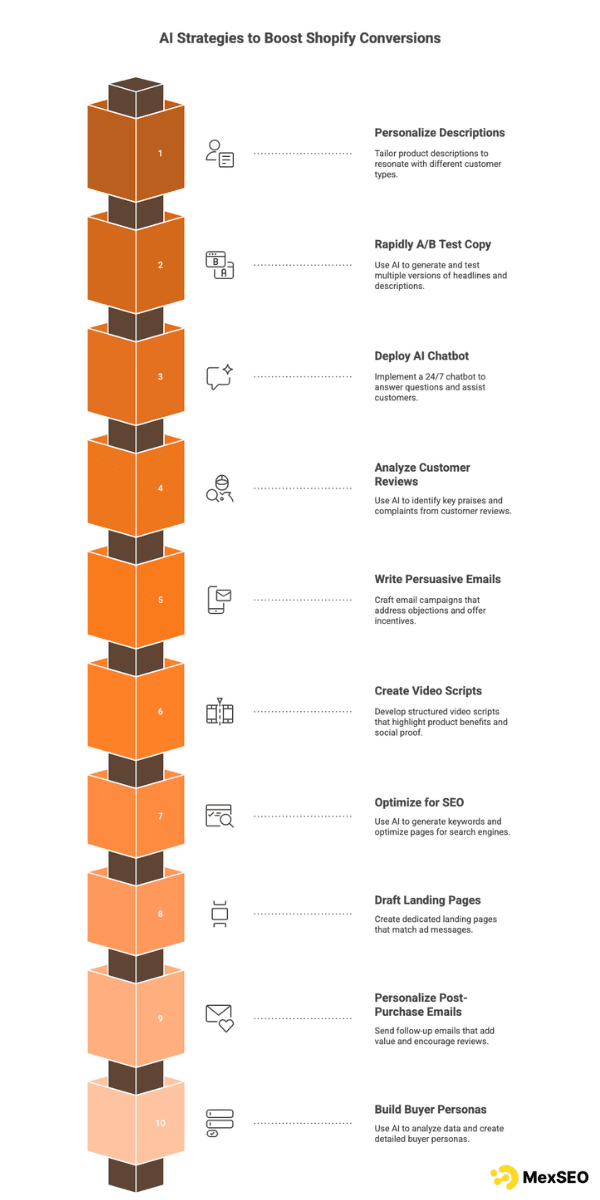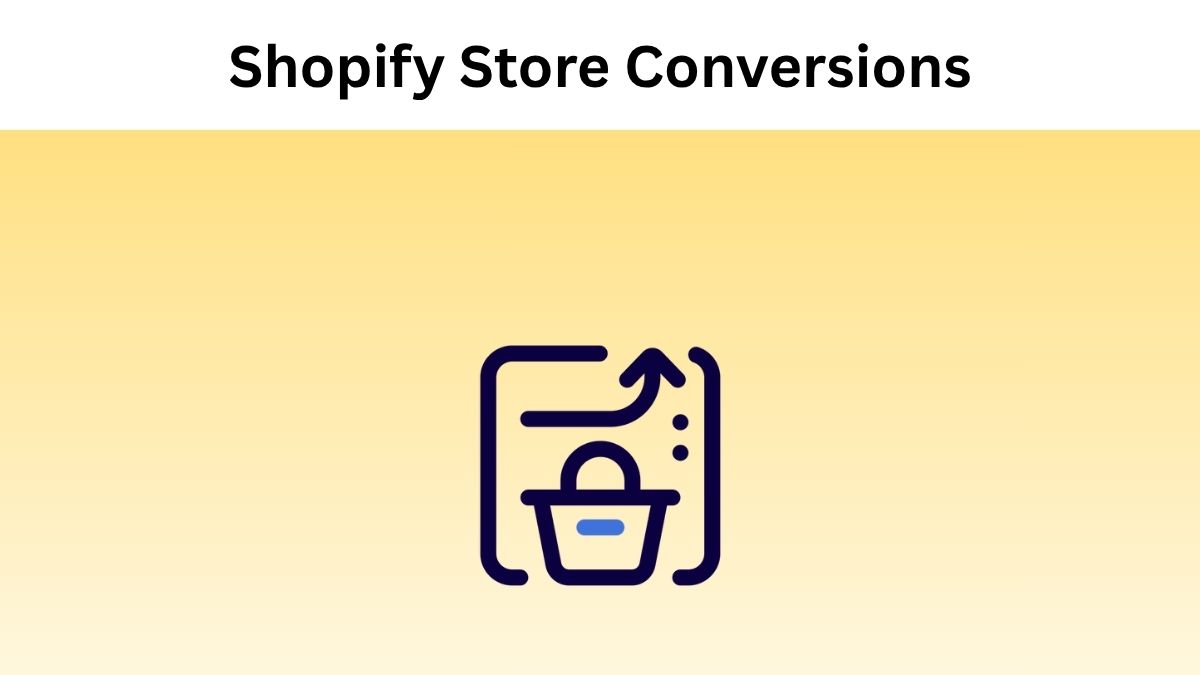Stop obsessing over traffic. In e-commerce, traffic is a vanity metric. The only metric that matters is your conversion rate. For Shopify owners, the daily battle is turning browsers into buyers. Your traditional playbook, clean UI, good photos, and fast load times are no longer a strategy. It is the mandatory cost of entry.
The new frontier is personalization at scale. This was once an impossibly expensive, resource-heavy task. Today, generative AI like ChatGPT is your new, strategic co-pilot. This isn’t a content-writing gimmick. It is an engine for understanding customers, personalizing experiences, and split-testing your way to a higher conversion rate.
This guide moves beyond “write me a product description.” You will learn 10 actionable strategies for using ChatGPT to increase Shopify store conversions that integrate AI directly into your Shopify workflow to drive measurable growth. This isn’t about replacing your intuition. It’s about amplifying it. This is your new success blueprint.
The Human-in-the-Loop
Before you write a single prompt, you must adopt the “human-in-the-loop” framework. AI is a phenomenal assistant, but it is not your brand manager, your strategist, or your final editor.
- AI Provides the Draft, You Provide the Brand. ChatGPT can generate ten email versions. Only you know your brand’s voice. You must use AI for speed and ideas, then you must refine and edit all output.
- Optimization Demands Measurement. Implementing these strategies without tracking their impact is a waste of time and money. You must define your baseline KPIs, Conversion Rate, Average Order Value (AOV), and Cart Abandonment Rate before you change a single headline.
- Focus on the Funnel, Not the Page. A single optimized page is a minor win. A fully optimized sales funnel is a business transformation. You must see these strategies as touchpoints along the complete customer journey.
- Test Everything. Never assume an AI-generated headline is better. The only way to know for sure is to test it. This entire process is conversion rate optimization (CRO).
With that framework established, here are 10 strategies to turn ChatGPT into your store’s dedicated CRO specialist.

10 Actionable Strategies for Using ChatGPT to Increase Shopify Store Conversions
Hyper-Personalize Product Descriptions
Your standard Shopify description is generic. It lists specs. A high-converting description speaks directly to a specific customer’s pain points and desires.
Instead of one description, you must use AI to write three distinct versions, each targeting a different buyer persona.
- Version 1: The “Problem-Agitate-Solve” Angle. Targets customers who are in pain and need an immediate solution.
- Version 2: The “Benefit-Driven” Angle. Targets aspirational customers who want to improve their lives.
- Version 3: The “Social Proof” Angle. Targets cautious customers who buy based on reviews and testimonials.
Pro Prompt: “Act as a conversion copywriter. Write three product descriptions for my [Product: ‘Enter Here’].
- Version 1: Use ‘Problem-Agitate-Solve.’ Target a busy professional in a distracting home office.
- Version 2: Focus on practical benefits relevant to the person’s profession and usage of the product.
Rapid-Fire A/B Test Variations
Your Shopify store has access to a powerful app ecosystem for exactly this purpose, and if you’re not using A/B testing in your business yet, you’re sitting on a pile of new opportunities.
Best for: Use apps like Shopify’s own ‘Search & Discovery’ app (which includes ‘Shopify Experiments’ for themes) or proven third-party tools like VWO or Neat A/B Testing. Plug your AI-generated copy directly into these tools to see what actually converts.
Pro Prompt: “My current product headline is ‘The Durable All-Day Backpack.’ Generate 10 alternative headlines.
- 5 must focus on scarcity (e.g., ‘The Bag Everyone Wants Is Almost Gone’).
- 5 must focus on a key benefit (e.g., ‘The Only Bag You’ll Ever Need’).”
Deploy an Intelligent 24/7 Customer Service Bot
Customers demand instant answers. If they have a simple question about shipping or sizing and can’t find an answer, they will abandon their cart. A 24/7 chatbot is a conversion-saver.
This isn’t just a defensive tool to answer “Where is my order?” It’s an offensive sales tool. An AI bot can act as a guided selling assistant, asking, “What brings you in today?” or “Are you shopping for a specific occasion?” and then recommending products, categories, or even a full Shopify SEO checklist for your store’s optimization.
Best for:
- Immediate Solution: Integrate a generative AI-powered app from the Shopify App Store. Tools like Tidio, Gorgias, or Re: amaze now use AI to understand intent and provide human-like answers based on your store’s data.
- Advanced Solution: For ultimate control, use the ChatGPT API to build a custom bot. This requires development, but specialized enterprise platforms from companies like LivePerson, Kore.ai, or Nurix.ai can build bespoke AI models trained on your specific product catalog to actively guide users to a purchase.
Pro Prompt (for drafting the bot’s knowledge base): “Act as a seasoned eCommerce support architect. Create a structured knowledge base for my online clothing store’s AI chatbot.
Uncovering Insights from Customer Reviews
Customer reviews often uncover a lot of possible improvements in hindsight. Export all of your reviews from the website (If you’re collecting them) or simply copy paste from online sources where your products are reviewed the most.
The next step is to paste them directly into ChatGPT and command it to perform an end-to-end sentiment analysis. It will tell you exactly what customers love and what’s causing friction.
Instead of waiting for the reviews, collect insights from visitors before they buy or abandon a page. Use specialized tools, such as Hotjar, Qualaroo, or Ometrics’ website feedback service, use non-intrusive tabs and widgets to capture this real-time sentiment, helping you spot friction the moment it happens.
Pro Prompt: “I’ve pasted 50 customer reviews for [Product]. Analyze this data and provide:
- A summary of the overall user sentiment on the product (positive, negative, mixed).
- The top 3 most-praised features.
- The top 3 most common complaints or points of confusion.
- A list of 5 ‘trigger words’ (positive and negative) that appear most often.”
Generate Persuasive Email Marketing Campaigns
Email marketing, especially for abandoned carts, is a conversion goldmine. Generic “You left something behind!” emails are ignored. You need to be more than the bare minimum these days.
Use AI to craft curiosity-involving, multi-step email sequences that address common objections, build trust, and offer smart incentives.
Pro Prompt: “Write a 3-email abandoned cart sequence for our Shopify store. The tone is [energetic and helpful].
- Email 1: A gentle reminder. Re-state the product’s main benefit.
- Email 2: Address a common objection (e.g., ‘Is it worth the price?’). Include a strong customer testimonial.
- Email 3: Focus on creating urgency, for example – Send them a set % of flat discount that expires in 24 hours.
Creating Engaging Product Videos
When done right, the high-quality product videos can drastically increase conversion rates of your Shopify store. They show the product in action, answer questions visually, and build trust. Stop guessing what to say.
Use ChatGPT as your video scriptwriter. It can structure a compelling narrative that hooks the viewer and guides them to a purchase by creating ample amount of traction with new users.
Pro Prompt: “Write a 60-second video script for [Product: ‘Enter Here’]. The script must follow this structure:
- 0-5s: A strong visual hook and a relevant + valid question
- 5-45s: Discuss the 3 key features and their benefits specific to the product that’s given to you.
- 45-55s: Show social proof (e.g., ‘See why it has 1,000+ five-star reviews’).
- 55-60s: A clear call to action (e.g., ‘Get yours today and take back control’).”
Engineer SEO-Driven Product & Category Pages
You cannot convert traffic you do not have, whether from Google AIO, social media, or paid ads. AI is an incredibly powerful SEO tool. It can identify long-tail keywords, understand search intent, and generate the FAQ and meta-description copy that Google’s algorithm demands.
Pro Prompt: “Act as an e-commerce SEO expert. My main product is a ‘women’s yoga mat.’
- Generate a list of 10 long-tail keywords and 5 related semantic keywords (phrases and topics related to the main keyword).
- Based on these keywords, write a 5-question FAQ section for the product page (e.g., ‘Is this mat good for hot yoga?’).
- Write a compelling, 155-character meta description.”
Draft High-Converting Landing Page Copy
When you run paid ads (Google or Facebook), you must never send traffic to your generic homepage. You need a dedicated landing page that perfectly matches the ad’s promise.
Use ChatGPT to write the entire copy for a landing page in minutes. This allows you to create unique, optimized pages for every single ad campaign, maximizing your ROAS (Return on Ad Spend).
Pro Prompt: “Act as a senior direct-response copywriter. Write a high-converting Shopify landing page for my [store name/type]. The traffic comes from a Meta ad offering 20% Off Spring Sale.
Create Personalized Post-Purchase Follow-ups
The conversion journey does not end at the purchase. The post-purchase experience is what creates repeat customers, the most valuable conversion of all, and generates product reviews.
Use AI to draft personalized follow-up emails that provide value, build community, and ask for reviews at the perfect time.
Pro Prompt: “Write a friendly, post-purchase email for a customer who just bought our [Product: ‘French Press Coffee Maker’]. The goal is not to sell, but to add value.
- Thank them for their purchase.
- Offer ‘One Quick Tip’ for getting the perfect brew.
Develop Data-Driven Buyer Personas
You cannot convert customers you do not know. You must stop guessing. Use ChatGPT as a data analyst. Feed it your Shopify analytics data (demographics, top referrers, AOV) and ask it to build detailed buyer personas.
Once you have these personas, you will use them as the foundation for all your other prompts (product descriptions, emails, ads) to ensure you are always speaking to the right person.
Pro Prompt: “I have data from my Shopify analytics: 65% female, 30-45, top-referrers are Pinterest and parenting blogs, average order value is $95, top-selling products are organic baby clothes. Create a detailed buyer persona for ‘Eco-Conscious Mom Maria.’ Include her motivations, pain points, and preferred brand voice.”
Summary Blueprint: AI as Your CRO Engine
| Strategy | Primary Impact Area | Effort Level | Potential Conversion Lift |
| Personalized Descriptions | Product Page | Medium | High |
| A/B Test Variations | All Pages | Low | Medium |
| 24/7 Chatbot | All Pages | High | High |
| Review Sentiment Analysis | Strategy | Medium | Medium |
| Email Marketing | Retention | Medium | High |
| Video Scripts | Product Page | Medium | High |
| SEO Optimization | Traffic/On-Page | Medium | Medium |
| Landing Page Copy | Ad Campaigns | Low | High |
| Post-Purchase Follow-up | Retention | Low | Low-Medium |
| Buyer Personas | Strategy | Medium | High |
Evolve or Be Left Behind
The role of the Shopify entrepreneur has fundamentally changed. You are no longer just a product curator; you are an experience optimizer. Generative AI is the single most powerful tool you have for this task.
By using these 10 strategies, you will shift from a reactive store owner to a proactive CRO expert. You must start now. Pick one strategy this week. Analyze your customer reviews. A/B test your main headline.
The path to higher conversions is paved with data, personalization, and relentless testing.


Comments are closed